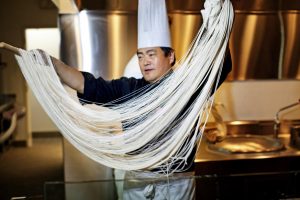
For many people the noodle is not only a source of nutrients, it “plays many roles… people use special food to celebrate important events and festivals” (Zhang & Guansheng, 2016). Mentioned in the Journal of Ethnic Foods reading are specific examples of the use of food outside of eating, such as the longevity noodle eaten at birthdays to signify a long life or eating noodles with gravy when moving into a new home to signify a flavored life. For many cultures there is significant meaning tied through noodles, but in particular Chinese culture seems to heavily depend on food for expression and significance. Much like Dr. Li mentioned in one of lectures that in Chinese culture being very open and upfront about emotions is not very common, love and affection for another person can be typically shown through the preparation, serving, and consumption of food.
For the Italians the noodle has a different but similar history and use. As mentioned in the History of Pasta reading, the noodle has existed in Italy for hundreds of years and it has been carried around the world wherever Italians migrated. Also mentioned in the reading is the use of fresh pasta in Italian culture signifies care and pride in the preparation of the pasta. Similar to Chinese customs of showing care and pride through food. Italians are also firm believers of the use of fresh and simple ingredients in their pasta dishes to preserve the authenticity of the dish. There is also a great deal of versatility in Italian pasta, with many different shapes and sizes such as Angel Hair/Capelli d’angelo or Farfalle (Butterfly) being mentioned in the An Intro to Italian Pasta reading. Italian noodle dishes are influenced from the region they come from such as Sicilian pasta including “many middle eastern ingredients, such as raisins and cinnamon” which has persisted from the time of Arabic invasions in Italy (Demetri, 2018).
The noodle has become a staple food in both Italian and Chinese culture because of the convince and meaning that they then grew to carry. Early noodles are traditionally made from wheat dough which is a leading crop in both China and Italy. Additionally, the noodle grew to signify different things for both the Chinese and Italians. Italians took great pride in the simplicity and freshness of preparing pasta noodles. While, in Chinese culture noodles can signify other things such as a long life. In both Italian and Chinese culture, the noodle is thought of as a healthy meal that provides many nutrients, particularly when paired with healthy sides. The noodle can be thought of as a healthy foundation for a complete meal.
After reading the story of the noodle, I have also come to understand that the noodle means more than a tasty filling meal. In the Crossing the Bridge noodle story, a young boy was banished to study with no distractions in a cottage until he was ready to pass his exams. The family chef was determined to feed him a meal that would bring comfort to the boy during his time in the cottage. The chef prepared many meals, however, they would all return untouched. The chef’s final meal was a noodle dish that he had prepared for the boy at a time of great illness. This dish of noodles was sent over and consumed by the boy. Highlighting that they were not considered a distraction to the boy’s studies but actually aided his study process. Furthermore, the story emphasized that the dish kept away the bad spirits and provide the nourishment necessary for the boy to pass his exams. This is the context that I have begun to think and define the noodle in. Noodles are a versatile nourishing meal made of dough, typically made to share and experience with others or to bring comfort to a loved one. The noodle has transcended cultural, linguistic, and international boundaries through its expression of care and love when prepared, served and consumed.
